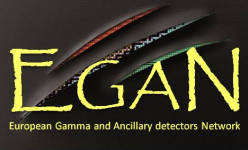Speaker
Franco Camera
(INFN and Univ. of MI)
Description
In the most recent years large volume LaBr3:Ce crystals have become available. The interest of the scientific community toward such kind of crystals is connected to its excellent scintillation properties. In fact, the LaBr3:Ce is an inorganic material which, when doped with 5% Cerium, shows the best energy resolution among all scintillators (2.7% a 661 keV) and an excellent subnanosecond time resolution. The LaBr3:Ce effective atomic number is high because of Lanthanum (Z=57) and its density is 5.1 g/cm3 which has to be compared with that of NaI (3.67 g/cm3), BGO (7.13 g/cm3) and HPGe (5.32 g/cm3) [1-3]. In addition, the crystal shows good temperature stability [4] and linearity in the production of scintillation light [5].
The first cylindrical 3" x 3" crystals have been produced in 2006 while in 2007 it was possible to reach the size of 3" x 6". In 2008 the first 3.5" x 8" detector has been delivered to Milano. Up to now we have received 6 large volume 3.5”x8” LaBr3:Ce crystals and for the end of the year an array of 10 of such detectors is planned to be ready to measure.
Such a system can be coupled to an HPGe array either to significantly increase its coincidence efficiency keeping a selectivity in -rays energy or in a standalone mode in case peak density is low enough or background it extremely high.
An overview of the R&D activity for the optimization of the performances of these detectors, of the tests with high energy g-rays and its expected performances will be given.
Primary author
Franco Camera
(INFN and Univ. of MI)

